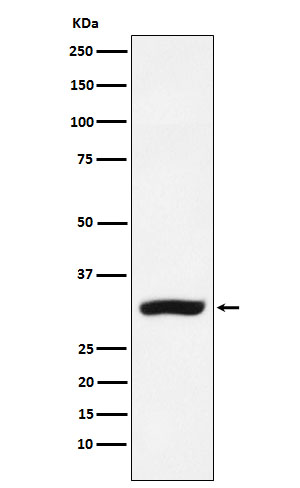
| WB | 1/1000-1/2000 | Human,Mouse,Rat |
| IF | 1/20-1/50 | Human,Mouse,Rat |
| IHC | 咨询技术 | Human,Mouse,Rat |
| ICC | 技术咨询 | Human,Mouse,Rat |
| FCM | 咨询技术 | Human,Mouse,Rat |
| Elisa | 咨询技术 | Human,Mouse,Rat |
| Aliases | CBR1; CRN; SDR21C1;;CBR1 |
| WB Predicted band size | 30 kDa |
| Host/Isotype | Rabbit IgG |
| Antibody Type | Primary antibody |
| Storage | Store at 4°C short term. Aliquot and store at -20°C long term. Avoid freeze/thaw cycles. |
| Species Reactivity | Human,Mouse,Rat |
| Immunogen | A synthesized peptide derived from human CBR1 |
| Formulation | Purified antibody in PBS with 0.05% sodium azide,0.05% BSA and 50% glycerol. |
+ +
以下是关于CBR1抗体的3篇参考文献示例(文献信息为示例性概括,实际引用请核对原文或数据库):
---
1. **文献名称**: "Carbonyl Reductase 1 as a Novel Target in Colorectal Cancer Therapy"
**作者**: Yokoyama, H. et al.
**摘要**: 该研究探讨了CBR1在结直肠癌中的表达及其与化疗耐药性的关系。通过使用CBR1特异性抗体进行免疫组化分析,发现CBR1高表达与5-氟尿嘧啶耐药性相关,提示其作为潜在治疗靶点的价值。
2. **文献名称**: "Role of Carbonyl Reductase 1 in Anthracycline Metabolism: Insights from Antibody-Based Inhibition Studies"
**作者**: Bains, O.S. et al.
**摘要**: 研究利用CBR1抗体探究该酶在阿霉素代谢中的作用。实验表明,抑制CBR1活性可减少阿霉素的毒性代谢产物生成,为减轻化疗副作用提供了新策略。
3. **文献名称**: "CBR1 Overexpression as a Poor Prognostic Marker in Breast Cancer: Immunohistochemical Analysis"
**作者**: Ahmad, S. et al.
**摘要**: 通过CBR1抗体对乳腺癌组织进行染色,发现CBR1高表达与患者预后不良显著相关,提示其可能作为乳腺癌的生物标志物。
---
如需具体文献,建议通过PubMed、Web of Science等数据库,以关键词“CBR1 antibody”或“carbonyl reductase 1 antibody”检索,并筛选涉及疾病机制、治疗应用或检测技术的研究。
The carbonyl reductase 1 (CBR1) antibody is a key tool for studying the CBR1 enzyme, a member of the short-chain dehydrogenase/reductase (SDR) superfamily. CBR1 catalyzes the NADPH-dependent reduction of carbonyl groups in endogenous compounds (e.g., prostaglandins, steroids) and xenobiotics, including chemotherapeutic drugs like anthracyclines. This enzyme plays a dual role in drug metabolism, influencing both detoxification pathways and the activation of prodrugs. Dysregulation of CBR1 has been linked to cancer progression, chemotherapy resistance, and neurodegenerative disorders such as Alzheimer’s disease.
CBR1 antibodies are widely used in research to detect and quantify CBR1 expression in tissues or cell lines via techniques like Western blotting, immunohistochemistry, and ELISA. They help elucidate CBR1's tissue-specific distribution, regulatory mechanisms, and interactions with substrates. In cancer research, these antibodies aid in exploring CBR1's role in drug resistance, as overexpression in tumors may reduce the efficacy of chemotherapeutic agents. Additionally, studies in neurodegeneration focus on CBR1's involvement in metabolizing neurotoxic aldehydes and amyloid-beta peptides.
The antibody’s specificity for human CBR1 (∼30 kDa) and cross-reactivity with homologs in model organisms (e.g., mice, rats) supports translational research. Its applications extend to biomarker discovery and therapeutic targeting, underscoring its importance in both basic science and clinical investigations.
×